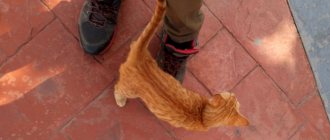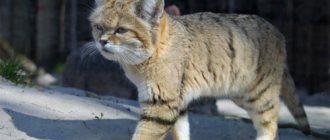Cats have different ways of communicating: one is through their body language. It's incredible what they can convey with their tail, eyes and ears. But what usually attracts our attention is its verbal expression; that is, meowing is not in vain, people are animals that, as a rule, we communicate through words, and that because of this we need to listen.
And of course, this is what our furry ones learn right away. In fact, if we observe a colony of cats, they usually do not meow, but our cat may do this often to communicate with us. But, do you know when cats start meowing?
What happens when you purr?
In general, purring is a vibrating, rhythmic and often quite long-lasting sound made by animals. As a rule, all representatives of the cat family purr. But some other animals, such as hyenas, mongooses, badgers and even bears, can also make similar sounds.
What happens during purring? For a long time, zoologists and scientists could not understand how cats purr, since there is simply no organ responsible for this process in the body of cats. But still, in the course of recent studies, it was found that cats begin to purr as a result of certain electrical impulses arising in the brain.
These impulses then travel along nerve endings to the muscles located next to the vocal cords. But muscles cannot make such sounds. And here the hyoid bones come into play, finely interconnected and located between the base of the tongue and the base of the skull.
Muscle contractions provoke vibration of these very bones, which results in the purring sounds that we all hear. Such sounds come from the animal's nose and mouth, but the vibrations spread throughout the body. And they arise both on exhalation and on inhalation. It is interesting that only small cats can purr; the structure of the hyoid plates of large ones is somewhat different, so they can only growl (and sometimes grunt or grumble).
By the way, if a cat starts purring at a veterinarian’s appointment, then he cannot listen to her lungs and heart. During the research, some characteristics of purring were also clarified. So, the frequency is approximately 22 to 24 hertz.
Newborn kittens: photo, development in the first 10 days of life
All kittens are born tiny, their weight on the first day of life is about 100 g. You can see what they look like in the photo. Newborn babies have their eyes closed and lack independent thermoregulation. Kittens cannot hear and cannot walk. Their behavior is determined by innate reflexes. Babies can sense the presence of their mother with the help of their developed sense of smell. They find it even at a distance of 60 cm.
The neonatal period (or newborn state) lasts 10 days. The development of kittens at this stage is still ongoing. They sleep most of the day, and when they wake up they try to find their mother's nipple and eat. Kittens need food every two hours.
Due to incomplete development, babies cannot empty their intestines and bladder on their own. The release of feces and urine occurs when the mother licks her young.
You can determine the age of newborn babies in days using the criteria indicated in the table:
| Days | Options | Description |
| 0–4 | Umbilical cord | The umbilical cord lasts up to 4 days, after which it disappears. |
| 5–8 | Ears | The ears, pressed tightly to the head, gradually open; the ability to perceive sounds appears in kittens 5–8 days after birth. It is important that at this time the room where they are kept is relatively quiet, since babies are just learning to respond to sound. |
| 10–14 | Eyes | Babies' eyes remain closed for several days after birth. They open only after 1.5–2 weeks. The color of the iris (blue) at the time of opening may differ from that of an adult animal. |
Maternal immunity protects cubs from viruses and bacteria; antibodies enter the body of kittens with the cat's milk. If newborn babies are left without a mother, then they have no chance of survival without outside help. Only a human or another cat can provide them with nutrition, bowel movements and urination, and a normal temperature level. By the end of this period, the kittens' weight ranges from 120 to 200 g.
Why do cats do this?
Why do cats still purr? Many people believe that in this way they show their positive emotions, but in fact there are some other reasons, and there are many of them:
- Most often, cats purring is a sign that they are feeling good. Almost all pleasant emotions are accompanied by this sound, which is why our little brothers purr when they feel protected (in the arms of the owner or in a comfortable chair), when they eat (this is also a pleasure, especially when the food is tasty), when they are stroked.
- Even kittens purr; such instincts (this also includes hissing, because cats can do this from a very early age) are inherent in felines almost at the genetic level. It has been proven that a kitten can begin to purr already on the second day of life. With this sound he can try to call the cat or tell her that everything is fine with him. Almost all kittens purr while feeding, indicating that they are happy.
- A recently lambed cat will communicate with kittens through purring: calling them to her, calming them down, and so on.
- Sometimes cats purr to attract their owner's attention, for example, when they ask for food or want to be held in their arms. And sometimes pets greet their owner in this way or even thank him for something.
- There is a theory according to which cats stimulate the production of special hormones through purring. They are synthesized in the brain and have relaxing, sedative, analgesic and antispasmodic effects. Scientists have recorded cases where wounded or injured cats purred actively. A cat may purr even if it is worried about something or is afraid. Often such sounds are made by sick cats, asking for help or trying to improve their condition. These are just assumptions, but cats are very smart, so anything is possible.
- And scientists from the University of California conducted research and found that vibrations that stimulate purring help strengthen bones. That is, cats that lead a sedentary lifestyle (reduced activity can lead to some diseases of the musculoskeletal system) protect themselves from fractures and other problems. In addition, vibrations also improve blood circulation, and with a sedentary lifestyle it slows down. But these are just assumptions, although quite reasonable.
- Many have noticed that when a person becomes ill, a cat miraculously recognizes the problem area, rushes to it and begins to purr intensely. Some believe that this is how pets heal their owners. Many have already tried to use purring to eliminate some human diseases and problems, but so far this treatment method is being studied, and its effectiveness has not been proven. But purring is already actively used by psychiatrists and psychologists to improve the condition of patients. In some cities and countries there are even whole ones where everyone can come to get their portion of “purring”.
- Cats can communicate with each other through purring. So, one animal from the cat family can use such sounds to show its desire to communicate or get to know each other better. A strong and dominant cat can purr if it wants to show another animal that it does not want to attack it or get involved in a fight. Sometimes cats purr to communicate that they are scared, that they are weak. Thus, the animals protect themselves from attack and try to win over the enemy.
2–3 month old baby: development, first vaccinations
By 7–8 weeks, the color of the iris becomes constant. Animals that have been trained to use a litter tray begin to look for it on their own, so they rarely make puddles in the wrong place. This is the right time to look for new owners.
The weight of a two-month-old kitten, depending on the breed, ranges from 400 to 900 g. This is the period when mother’s milk ceases to be an integral part of the daily diet of older babies. They occasionally cuddle with their mother to feast on her and feel her warmth and care, but the animals feed on their own. For a two-month-old pet, feeding five times a day is optimal. Water must always be available.
At 2 months, pets begin to purr if they enjoy petting. Kittens become extremely active, they get into the most inaccessible places, they can run out the door and end up on the street. The owner should be especially careful when leaving the house.
At 2.5 months, babies receive their first vaccinations. However, if there is a risk of early infection with dangerous infections, then vaccination is carried out earlier than 8 weeks.
A three-month-old kitten has a well-developed musculoskeletal system, he knows where his bowl and tray are, and willingly comes running when his name is called. The body weight of a three-month-old cat is about 1.3 kg.
What if the cat doesn't purr?
As already noted, everyone purrs. But what to think if the cat doesn't do this? This can be quite a warning sign that there are problems. Carefully examine the animal to rule out the possibility of illness or illness.
The pet is probably just not in the mood. Try to pick him up, stroke him, talk to him kindly. If there is no purring for a long time, take your cat to the vet. The absence of purring may indicate problems with the ligaments or even with brain function.
It was noted above that during vibrations the doctor cannot listen to the heartbeat. But many veterinarians use an interesting technique. They turn on the water tap, reducing the pressure to a minimum. The sound of a trickle of water is probably similar to the vibrations produced by the hyoid bones. And when a cat hears such a sound, it stops purring.
Now you have learned a little more about such seemingly native, but at the same time absolutely unknown and unpredictable animals like cats. Let your pet always please you with his purring.
In every home where a cat lives, any family member knows that there is no better consolation after a difficult and difficult day than the purring of a pet. These gentle grumbling sounds, which are similar to the work of a small tractor inside, are made by cats before they even open their eyes, literally from the cradle. This is a way to talk to a person. Why do cats purr, what do they mean by this? Is this a way of cuddling or is the cat telling you how your day went? There are several versions of the origin of such a pleasant sound.
The process of purring begins in the brain, which, as a result of external influences with the help of impulses, gives a signal to the muscles of the vocal cords, which produce vibration as a result of which purring occurs.
To the question: why do cats purr, there is another physiological theory: the reason is in the special structure of the larynx, namely the so-called hyoid bones; when these bones move, vibrations occur, which cause characteristic sounds.
Some scientists believe that a cat itself can cause purring by contracting the muscles of the larynx in a special way during the breathing process.
2–3 weeks: hear, see, begin to walk
In the second week, kittens are actively developing, their hearing continues to develop, but they are not yet able to navigate by sounds. By the end of the second week, babies' eyes open, but vision does not immediately become clear. At the same time, the kitten makes its first attempts to rise on its paws; it cannot yet walk confidently.
Babies see their brothers, sisters and mother for the first time, they learn to communicate, and begin to fight for mother's milk. When they go to bed, they sit closer to each other and their mother. During this period, animals become accustomed to humans. In order for a cat to grow up tame and affectionate, you need to take them in your arms every day. At first, communication with a person lasts only a couple of minutes, but gradually the duration of contact increases.
Cat Behavioral Signals
To the question of where the purr is located in cats, we were answered by scientists' theories, but what prompts cats to make this sound, why do cats purr when you stroke them, what prompts animals to do this? Or why do cats purr in response to stroking from a stranger? The answers to these and other questions related to cats can be found below.
Little blind kittens, when suckling their mother's breast, make a purring noise while feeding, thereby signaling to their mother that they are healthy and eating with pleasure.
Mothers, when communicating with their children, kittens, purr, thereby informing them that she is nearby and is always ready to help and protect her offspring. Read the article about caring for cats and newborn kittens.
This is an antidepressant for the cat itself; thanks to purring, it calms down in some uncomfortable situations. This neutralizes the cat's nervous excitement, gradually returning it to its normal state, calming the animal.
A feeling of gratitude, a kind word, stroking, a piece of treat that the animal received from the owner, all this causes the pet to react, as a result of which he purrs, expressing his gratitude.
Purring helps a cat fight illness by activating blood circulation and metabolism, and even helps the animal improve its heat exchange if it is very cold.
Greeting: Cats purr when meeting new people or other animals and members of their own species.
This shows that they are not aggressive, but kind, and reveals the character of the cats (whether the animal is a contact person or whether it is worth paying attention to problems in psychology).
Extortion: cats often use this technique in an effort to achieve what they want, either to get a tasty piece of forbidden sweets, or asking for another dose of caresses and strokes from the owner.
To achieve internal balance before bed, the timbre of purring allows the cat to relax, this helps to get a good night's sleep and gain strength.
A cat makes a loud, threatening purr when something threatens the animal itself, or someone encroaches on food or territory. At such moments, the pet becomes tense, the tail trembles, and if you try to touch the animal, you can get quite a bit of damage from the claws.
Sometimes purring can be heard from a cat while playing, holding a toy in its paws or watching it from an ambush, the animal makes soft rumbling sounds, this is a manifestation of the hunting instinct of its ancestors, which is inherent in every cat, no matter whether they are domestic or wild.
For a true cat lover, there is no better music than the gentle purring of a pet, its contented, muffled purr. It has long been believed that representatives of the tailed-striped family make these sweet, soothing sounds when they are at the height of bliss. But is this really so?
Just watch the cute furball for a little while and you will immediately notice that your kitten makes purring sounds not only when you pet him. With them he greets his mother, begs for food, and responds to pleasant dreams.
Even reputable scientists decided to understand why kittens purr. Together with eminent veterinarians, they found out that very often animals relieve stress or anxiety with this sound, calm themselves, and find inner balance.
In addition, the researchers made several startling assumptions, including:
- This is how kittens maintain normal muscle tone;
deep guttural vibrations create a healing effect - bones grow faster in animals and wounds heal in case of injury. This also explains the “medicinal” effect of cats on their owners.
As it turns out, purring is not always an indicator of a cat’s positive emotions or good mood. Sometimes it is a “sedative” during a difficult period for the animal. But an attentive owner can easily distinguish a gentle rumbling from nervous, excited sounds.
Why does a cat have no voice from birth?
If your pet refuses to meow, this does not mean that the kitten does not have a voice. There are more talkative and completely silent cat breeds. They behave quietly:
- British;
- Scots;
- Maine Coons;
- Norwegian forest;
- Siberian;
- Cornish Rex;
- Devon Rex.
Of course, there may be exceptions here, but among these breeds there were often cases when cats did not meow for 10-15 years, they only purred. And in old age, animals used to become overly talkative.
There is no need to look for reasons for a cat’s deafness or muteness; deaf cats meow beautifully, but dumb cats are practically never found. Most often, if a cat doesn't meow, he just doesn't want to do it. And there is no need to worry about silence, unlike situations when the voice suddenly disappeared.
However, even here the “muteness” may turn out to be transitory, and if the kitten meowed “something wrong” a couple of times, and then everything was restored, this is not a reason to worry.
So, wondering why the cat lost his voice makes sense solely out of curiosity. If you are afraid of illness, then the animal will show more noticeable symptoms, except for missing sounds. And to protect your pet from the deadly disease rabies, just get vaccinated annually.
A letter recently arrived in my Question and Answer column. I decided that the topic of the letter was worthy of everyone’s attention and would be of interest to many.
I get asked similar questions often. I decided to write a detailed answer so that everyone could find out why a cat can suddenly stop meowing.
If a talkative cat suddenly becomes silent for an extended period of time, some of the owners' concerns about this may be justified. Especially if the cat seems lethargic or depressed despite all this. Visit your veterinarian for a full examination, it never hurts. If your cat has always been silent and at the same time looks healthy and cheerful, then she probably just has such a character and this is completely normal.
Some breeds are initially predisposed to vocalize a lot, for example, oriental cats, which necessarily voice their every action and request. At the same time, there are quiet cat breeds, for example, the sacred Burma. Of course, it cannot be said that 100% of Siamese will meow around the clock and 100% of Burmese will be silent all the time; individual character traits cannot be ruled out. But if your loud Siamese suddenly fell silent, and your quiet Burmese began to scream heart-rendingly all day long, this is a cause for concern.
Adult cats do not use meowing very often when communicating with each other. They use screams, purrs, purrs, but not a full and clear MEOW. In nature, only kittens use this sound to call their mother cat. Scientists believe that domestic cats began to meow over time and into adulthood because humans respond best to this sound. The meow that cats use to communicate with people is a domestication trait and a way for cats to communicate with their owners. Because adult cats don't meow at each other, your cat may also become quieter as an adult, even if she meowed a lot as a child.
If your cat is stressed, she may either start meowing more or become quieter. For example, if you brought a new animal into the house, you moved to a new place of residence, your family composition has changed, all this can affect the cat's vocalization. Often, cats in new premises walk around and meow aimlessly. They seem to explore the room using echolocation. But no. This way they get rid of the frustration associated with the stress of having to master a new territory.
And in the case when a new animal appears in the house and the cat is frightened by this event, it may temporarily stop meowing in order to hide its presence.
I often come across cases where kittens and cats that grew up on the street without human company do not seem to know how to meow. Often they are generally silent or use purring, squeaking, and purring instead of meowing. For example, my wild friend Marusya has never meowed for me. When she asks for food, she turns on a loud purr, and uses thin squeaks similar to meowing only in dialogues with other cats.
If you still don’t understand what caused your cat to stop meowing or change the timbre and volume of meowing, then you must, first of all, rule out medical reasons for this behavior.
You must exclude the following diseases:
Upper respiratory tract infection
As in humans, an upper respiratory tract infection (feline rhinotracheitis) can cause hoarseness and laryngitis. If your pet is also experiencing symptoms such as a runny nose, watery eyes, lethargy, or discharge from the nose and eyes, a lack of meowing may be a symptom of a respiratory infection. The vet will likely treat this with antibiotics or other medications. If your cat is vaccinated on time, the only sign that she has caught the infection may be a change in her voice or a slight sneezing. In order to confirm the diagnosis, swabs from the mucous membranes of the nose and eyes can be tested. The result will confirm or deny the presence of the virus in the cat.
Hyperthyroidism
In older cats, an overactive thyroid gland can cause hoarseness and weight loss. If you observe symptoms in your cat, in addition to hoarseness, such as extreme thirst, poor skin and coat condition, and hyperactivity, then ask your veterinarian to take blood tests for thyroid hormones from the cat and suggest therapy.
Laryngeal paralysis
Damage to the nerves in the larynx, although rare, can cause muteness and also interfere with a cat's breathing. The condition can also cause coughing, weight loss and difficulty swallowing. This is a very serious situation that requires immediate medical attention, and you will likely notice other symptoms before your cat stops meowing.
Tumors or polyps
The growth of various formations in the cat's throat and vocal cords can cause it to stop meowing. These can be benign polyps or malignant cancers. If your cat suddenly begins to wheeze, sneeze, cough, has difficulty breathing, or has recurring ear and dental infections, take her to the vet to be examined for growths.
In most cases, a cat’s silence is simply a character trait, an age-related change, or a feature of the breed, and in such cases you have no reason to worry. But if silence is accompanied by other alarming symptoms, you should first of all contact a veterinarian.
And I want to say one more thing. If your cat is quiet, just enjoy it! You can’t imagine how many people dream that their cat would be silent for a little while!
If you do decide to teach your silent cat to meow, there are a few clever tricks you can use. For example, meow to the cat yourself, pausing between your “meows”, as if waiting for an answer. Play an audio recording or show a video of cats meowing to see your cat's reaction to it (just choose a non-aggressive meow to avoid your cat reacting aggressively in return). Talk to the cat yourself more often, make sure that she understands that you are addressing her, take pauses in the conversation.
If the cat meows, praise it and give it a treat.
Just don’t say later that I didn’t warn you! Teaching a cat to meow can be very simple, but weaning it is much more difficult. So think a hundred times, do you need this?
A long-awaited pet has appeared in the house, but instead of joy, the household gets a problem. The kitten becomes active at night, meows and does not allow sleep. Why does this happen? How to stop a kitten from crying at night?
When is specialist help needed? This article answers the questions raised.
- What a kitten's meowing could mean: 6 reasons
- Why does the kitten meow for no reason?
- What to do if the kitten does not sleep at night, walks and meows
- How to quickly calm a meowing kitten?
- Anxiety in your kitten that requires you to contact your veterinarian
- Conclusion
How does a kitten purr and where is the “purr” located in the cat’s body?
There are still many theories that try to explain how a kitten purrs, and none of them have been proven. The most reliable version attributes the occurrence of these sounds to the so-called “Jacobson's organ,” which is located in the palate of a cat and is also used by it to recognize odors. However, this is just a theory.
Man conquered space and the depths of the oceans; he was able to reveal the secret of the atom and see the smallest cells of the body. And the secret of such a pleasant cat “mur-mur” remains unsolved!
One of the reasons why a person chooses a cat as a pet is its ability to express positive emotions and share them with others through purring.
But few people know: in what cases do cats purr, why do they do it, and how do they do it?
How to introduce first complementary foods
The first feeding should be introduced with caution. It is necessary to offer your pet new food gradually, in small portions. Please remember that cats, like people, can have allergies. Therefore, they offer to lick new food off the finger first, and only the next day a small portion is served in a bowl.
Table: sample menu for kittens
| Kitten age (weeks) | Type of complementary foods | Quantity (one time) |
| 3 | Milk | 10–16 ml |
| 4–5 | Milk + porridge | 16–18 ml/g |
| 5–6 |
| ~20 g |
| 6–8 |
| 30–40 g |
| 8–10 |
| 40–50 g/according to package instructions |
What is purring? How does it manifest itself?
Purring (purring, rumbling) is considered to be a not very loud, vibrating sound with a certain rhythm and duration that is made by representatives of the cat family.
It is believed that the smallest of them purr most often: domestic cats and lynxes. Purring has also been observed in cheetahs, pumas, and leopards. Some sources claim that even lions and tigers can purr.
However, there is no consensus on this issue among scientists: many of them say that large representatives of cats cannot purr due to the special structure of the hyoid bone.
What are the benefits of a cat's purring for humans?
A cat in the house is a living anti-stress. In any case, many owners are sure of this. Indeed, the purring of an animal is very calming and even lulls you to sleep. But cats are also real healers. Let's list what miracles they can create only with the help of their purrs, based on research by Californian scientists:
- Cat sounds, usually made at a frequency of 27-44 Hz, help strengthen bone tissue;
Frequent communication with domestic cats is indicated for people suffering from nervous disorders;
Regular listening to cat songs helps strengthen the immune system, which means it prevents frequent illnesses;
The sounds of purring improve a person’s cerebral circulation, normalize blood pressure, and calm a rapid pulse;
When do cats purr, and what does this mean?
When communicating with kittens
For the first time, a cat begins to purr at a very young age, a couple of days after birth. Kittens make these sounds to show their mother that they are happy and calm - for example, during feeding.
Sucking milk and meowing is difficult, but sucking and purring is something any kitten can do. The cat also purrs to her kittens - in this way she supports them, encourages them, calms them down if necessary, and shows her love and care for the offspring.
In collisions with other cats
Adult cats and female cats purr to each other, showing friendliness, and through purring they signal that they do not claim someone else's territory. It also happens that purring occurs during an attack - in this case, it is a way to show your defenselessness and an attempt to get away from the aggression of another cat.
As a sign of gratitude to people
If we talk about cats purring in the company of people, there are several possible reasons:
- they purr, wanting to attract the attention of the owner;
- they ask to be fed or simply treated to some favorite treat (begging for a treat);
- from pleasure. This is very noticeable when you stroke and caress them.
Cats can also purr to greet you at the doorstep or express gratitude (for being fed or caressed).
In all these cases, purring is a manifestation of positive emotions that the cat is experiencing.
During purr therapy
In addition, scientists associate the theory of strengthening bones with purring through the vibration that occurs with it. To date, British specialists have discovered and documented in the literature an effect called “purring therapy.”
Confirmation of the “work” of this therapy in practice are the results of long-term studies, during which the effect of purring on the relief of swelling, pain, shortness of breath, and acceleration of the healing process in the treatment of tendon and bone injuries was established.
Purring stimulates the cat's brain to produce a special hormone, which in turn acts primarily on the cat itself - as a sedative or pain reliever.
However, a cat is capable of treating not only itself, but also other cats, and even humans. Pay attention to how cats come to you when you are sick, where they lie down, what places they trample with their paws, and what sounds they make when doing so. With a high probability we can say that it will be a cat’s purr.
As you can see, cats have a lot of reasons for purring and it all depends on the situation. At the same time, the purring itself can differ significantly - in intonation, tempo/rhythm, sound timbre.
If you know your pet well, in most cases you can determine the cause of the purring yourself.
At what age do kittens begin to purr?
Everything here is individual: there are kittens that can purr after birth - at one day of age. They do this, feeling maternal protection, love and delicious milk. Others take several weeks or months to learn. There are cats that can purr from 6 or 11 months, and there are those that will never do this - you will not be able to determine the baby’s character and preferences in advance.
Note! Not only is everyone’s age different, but the frequency of sounds is individual - some individuals constantly sing a song, while others find it difficult to hear a pleasant sound, even if they feel very good.
If your cat's purring suddenly stops, you should look for the reason. Perhaps the baby has some health problems, he feels weak and unwell. Source: Flickr (Vasquezz)
How do cats purr?
We are able to observe the purring, understand the reasons and reasons for its occurrence. But what can we say about the mechanism for producing these purring sounds? Oddly enough, it has not been fully studied by scientists.
What is clear is that a special organ that would produce such sounds was not found in cats. Otherwise, instead of a clear answer, we are offered a number of scientifically based assumptions/theories:
- The purring is caused by the vibration of the cat's lungs.
- Occurs when there is a change in blood movement/circulation in the cat’s body.
- In recent studies, the mechanism of purring is described as a sequence: “the appearance of electrical impulses in the cat’s cerebral cortex - the vocal cords receive these impulses - contraction of the muscles associated with them.”
How does the mechanism for producing purring sounds work?
The “purring apparatus” itself is a thinly connected hyoid bone, which is located between the base of the skull and the base of the tongue. But it is the contraction of the muscles near the vocal cords that causes them to vibrate, and, accordingly, the appearance of purring sounds.
At the same time, the cat’s mouth and nose participate in their reproduction, while the vibration spreads throughout its entire body. One of the features of purring is the inability to listen to the cat’s heartbeat and monitor its breathing.
If necessary, to stop the sounds of purring, it is recommended to turn on the water from the tap - while it flows, the cat stops purring.
Thank your pets for purring!
We should be grateful to purring cats for their amazing sensitivity, ability to relieve stress, calm anxiety, reduce headaches and stabilize blood pressure.
You and I don’t purr, but we can show our love and care in other ways, say “thank you” for being there, pet them or treat them to something tasty. Our attention to them will be the best gratitude!
The sound of a purring cat is my favorite sound (c)
Tim Sobakin.
The measured and loud purring of cats gives their owners many positive emotions.
While stroking an animal and hearing its rumbling, feeling its small body vibrating slightly under your fingers, it is difficult not to calm down and feel inner peace. The purring of cats is one of the main mysteries of these animals, which for decades has tormented not only lovers of these pets, but also major scientists around the world.
What do these sounds mean? How are they published? Why does a cat purr only in a peaceful and calm state? Over time, answers to all these questions were found.
The purring of cats is one of the main mysteries of these animals.
Why do cats purr?
Many cat owners have probably noticed that their pets purr gently and measuredly only when they feel good and calm.
Cats purr only in a place where they feel good and calm.
Climbing onto the owner’s lap or huddling next to him in bed, the animal turns on its “tractor,” filling the space with measured sounds.
Scientists' opinion
Scientists have found that purring is primarily a way for adult cats to interact with their young.
When kittens are still blind and helpless
, the cat, by licking and purring, tells them that everything is fine, that mom is nearby, they are safe. Returning from a hunt or from a walk to the habitat of the kittens, the animal lets its cubs know with a loud purr that it is she and they are not in danger.
When the kittens are still blind, the cat tells them by licking that everything is fine.
But what does rumbling mean for an adult cat in relation to a person? Why, as soon as you stroke her, the surrounding space is filled with a long and loud purring? It turns out that when a cat becomes attached to its owner, it begins to behave towards him in much the same way as towards its cubs.
What does it mean when a cat purrs?
When a cat purrs next to its owner, it feels safe.
And in the same way, with her purring, she lets him know that:
- the owner is safe;
- the cat is nearby and she will not leave her owner;
- the cat feels good and peaceful.
Menacing purr
When taking an attack pose, a cat may purr threateningly.
But besides peaceful and measured purring, cats have other types of rumbling, including one of the most common - threatening.
When a pet feels that it, its cubs, or its owner are in danger, it may begin to make aggressive purring sounds. At the same time, the animal assumes a posture for attack - paws spread, arched back, slightly tilted head. Also, in some cases, purring can be a sign of anxiety in a cat.
The cat is sick
In severe pain, cats rumble dully and deep in low frequencies.
Pets can make purring sounds not only during periods of aggression or calmness, but also when they feel unwell.
For example, when there is severe pain, cats rumble dully and deep at low frequencies. Usually this is not at all similar to the usual peaceful purring of a pet, and an attentive owner can immediately notice that his pet is sick.
Purring mechanism - how do cats purr?
For a very long time, many zoological scientists struggled with the riddle
organ responsible for a cat's purring.
The rumbling is associated not so much with the internal organs of the cat, but with its brain activity.
At first it was believed that the rumbling was produced by the stomach, then theories were put forward that the cat has a special “purring” organ next to the spleen.
For many years, research on animals led to nothing, until one of the scientists put forward a hypothesis according to which rumbling is associated not so much with the internal organs of a cat, but with its brain activity. And indeed, the animal’s brain sends certain impulses to the body, as a result of which this enchanting sound is heard.
Where does the sound come from?
The cat's hyoid bones interact with the vocal cords to produce a purr.
But the question still remained open, which organs are responsible for the physical transmission of sound in space.
The answer was found just a few decades ago - the thin hyoid bones of a cat interact with the contracting vocal cords as a result of a signal received from the brain. It is this interaction that creates such amazing sounds that the animal can use at its discretion.
Amazing facts
During purring, subtle vibrations pass throughout the cat's body.
Scientists have noted such amazing facts about feline purring as:
- during purring, the finest vibrations
; - the peaceful purring of cats has a certain frequency
, at which the process of cell regeneration in their body occurs faster; - Cats make the purring sound through their nose and mouth at the same time
; - during rumbling, it is impossible to listen to such organs of cats as the lungs and heart
; - some unique individuals can purr and purr at the same time
. Other cats and female cats are unable to make both sounds at the same time.
Newborn kittens learn to purr already on the second day of their birth, repeating after their mother. And most adults do not lose this ability until death.
Rumbling and purring of other animals
Cheetahs can make purring sounds.
Contrary to the popular belief that only domestic cats and cats purr, nature has endowed other animal species with this ability. Among them:
- some large felines, such as cheetahs;
- badgers. These animals produce purring sounds at lower frequencies than most felines;
- bears can also purr with pleasure;
- gorillas make purring sounds when defending their prey or caressing their babies;
- rabbits;
- raccoons;
- lemurs.
Interestingly, lions cannot roar.
Scientists studying the physiology of these animals have found that under their throats there are cartilages similar to those found in domestic cats. But their structure is slightly different from that of a cat, and the cartilage itself is more rigid. That is why the lion can roar loudly and menacingly, but does not have the ability to peacefully purr and rumble.
Why does a kitten meow when it goes to the toilet?
Meow
animals in
the toilet
and because they experience pain. Very often this happens to kittens whose diet has changed dramatically - from mother's milk to more serious food. Fecal masses have become much denser, and this makes it more difficult to do “big things.”
Interesting materials:
How to see in Viber when a person was online? How to put a notification on a person on Insta? How to put a notification in VK that a person is online? How to congratulate a person on his birthday? How to congratulate a person on his birthday? What is the correct name for Older Person's Day? What is the correct name for the holiday Day of the Elderly? How to wear a mask correctly for a healthy person? How to eat properly for a healthy person? How to tell a person about dismissal?










